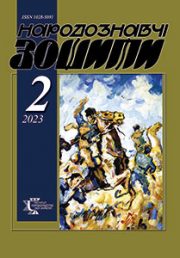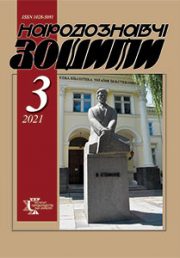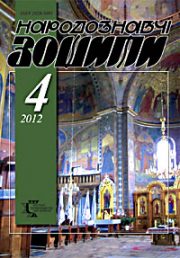The Ethnology Notebooks. 2021. № 6 (162), 1413—1434
UDK316.658″1991/2021″:94-05](477)
DOI https://doi.org/10.15407/nz2021.06.1413
ATTITUDE TOWARDS STALIN IN UKRAINIAN SOCIETY AFTER 1991: MAIN TRENDS AND FACTORS
SUDYN Danylo
- ORCID ID: https://orcid.org/0000-0001-5648-0224
- Candidate of Sciences in Sociology,
- Research Fellow of Department of Social Anthropology,
- The Ethnology Institute of National Academy of Sciences of Ukraine,
- Associate Professor at Sociology Department,
- Ukrainian Catholic University,
- Contacts: e-mail: dansudyn@gmail.com
Abstract. The article examines the dynamics of attitudes towards Stalin in Ukrainian society during 1991—2021 — using data of sociological surveys conducted in Ukraine at that time. The main methodological problem is the use of identical wording in different surveys: in the case of using different questions the data is incomparable. The article provides list of the main questions used in surveys studying attitudes towards Stalin. The choice of one of them is explained. This question required respondents to express the level of their agreement or disagreement with the statement «Stalin was a great leader». Article provides empirical analysis, which shows that this question can serve as a valid indicator of attitude towards Stalin. The second component of the article is an analysis of trends in attitudes towards Stalin. In particular, the data were analyzed according to different age cohorts and obtained result shows that all of them have the same dynamics of attitude, although the level of positive attitude towards Stalin is different age groups. The third component of the article is an analysis of the main factors of this attitude. A general theoretical model is proposed, which includes four factors: social injustice (with subfactors of ontological security and financial situation), authoritarianism, conservatism and identity (with subfactors of ethnic self-identification and the idea of «fraternal peoples»). Two additional factors are also taken into account — the age and region of residence of the respondents. The main method of data analysis was multiple linear regression, which was applied to data of 1991, 2002 and 2006 surveys. Three regression models were built — the base and two additional. This was inevitable, as not all variables were present in all three waves of the survey. The obtained results allowed to identify both the main factors of attitude to Stalin and to identify trends in their role over time. Thus, there are four periods in relation to Stalin in Ukrainian society after 1991, and different factors change their role during these periods. But the article aims not only to analyze the attitude towards Stalin, but also to identify patterns of relations to the Soviet past in Ukrainian society. The attitude towards Stalin is one of the aspects of this past. Therefore, the obtained results can serve as source of hypotheses for further research about the memory of the Soviet period in the history of Ukraine.
Keywords: historical memory, collective memory, Stalin, Ukrainian society, public opinion, social factors.
Received 1.09.2021
REFERENCES
- Hrytsenko, O. (2014). Memory of Local Production. Kyiv: K.I.S. [in Ukrainian].
- Haidai, O. (2018). The Stone Guest. Lenin in Central Ukraine. Kyiv: K.I.S. [in Ukrainian].
- Tismaneanu, V. (2000). Fantasies of Salvation: Democracy, Nationalism and Myth in Post-Communist Europe. Warszawa: Muza SA. [in Polish].
- Novikova, L. (2018). The Attitude of the Citizens of Ukraine and Russia to Stalin. Retrieved from August 30, 2021: https://kiis.com.ua/?lang=ukr&cat=reports&id=760&page=1 [in Ukrainian].
- Novikova, L. (2019). The Attitude of the Population of Ukraine to the figure of Stalin Retrieved August 30, 2021 from: http://www.kiis.com.ua/?lang=ukr&cat=reports&id=872&page=3 [in Ukrainian].
- Novikova, L. (2021). The Attitude to Stalin. Retrieved August 30, 2021 from: https://kiis.com.ua/?lang=ukr&cat=reports&id=1048&page=1 [in Ukrainian].
- Koposov, N. (2011). Strict-Security Memory: History and Politics in Russia. Moscow: New Literary Observer [in Russian].
- Gudkov, L. (2017). The Great Terror and Repressions. Retrieved August 30, 2021 from: https://www.levada.ru/2017/09/07/16561/ [in Russian].
- Levada-Center. (2018). The Perception of Stalin. Retrieved August 30, 2021 from: https://www.levada.ru/en/2018/04/17/the-perception-of-stalin/.
- Pipija, K. (2018). Stalin in public opinion. Retrieved August 30, 2021 from: https://www.levada.ru/2018/04/10/17896/ [in Russian].
- Volkov, D. (2021). Stalin-Centre and Stalin monument. Retrieved August 30, 2021 from: https://www.levada.ru/2021/08/04/stalin-tsentr-i-pamyatnik-stalinu/ [in Russian].
- Yarlykova, M.M., & Xunda, Yu. (2020). Rethinking war history: the evolution of representations of Stalin and his policies during the Great Patriotic War of 1941—1945 in Soviet and Russian History Textbooks. Studies in East European Thought, 72, 161—184. Retrieved from: https://doi.org/10.1007/s11212-020-09361-7.
- Gugushvili, A., & Kabachnik, P. (2015). Stalin is dead, long live Stalin? Testing socialization, structural, ideological, nationalist, and gender hypotheses. Post-Soviet Affairs (Vol. 31, issue 1, pp. 1—36). Retrieved from: https://doi.org/10.1080/1060586X.2014.940697.
- Kabachnik, P., & Gugushvili, A. Unconditional love? Exploring hometown effect in Stalin’s birthplace. Caucasus Survey (Vol. 3, issue 2, pp. 101—123). Retrieved from: https://doi.org/10.1080/23761199.2015.1044305.
- Kabachnik P., Gugushvili, A., & Kirvalidze, A. (2020). What about the Monument? Public Opinion and Contentious Politics in Stalin’s Homeland. Problems of Post-Communism (Vol. 67, issue 3, pp. 264—276).
- Waal, T. de. (Ed.). (2013). The Stalin Puzzle. Deciphering Post-Soviet Public Opinion. Washington: Carnegie Endowment for International Peace. Retrieved August 30, 2021 from: https://carnegieendowment.org/files/stalin_puzzle.pdf.
- Gugushvili, A., & Kabachnik, P. (2019). Stalin on Their Minds: A Comparative analysis of Public Perceptions of the Soviet Dictator in Russia and Georgia. International Journal of Sociology (Vol. 49, issue 5—6, pp. 317—341). Retrieved from: https://doi.org/10.1080/00207659.2019.1661559.
- (1991). Kyiv International Institute of Sociology. Survey-1991: Views of Ukrainian People on Political Problems and Mass-Media. Retrieved August 30, 2021 from: https://ukraine.survey-archive.com/data#user-research@showResearch=91668.
- (2002). Kyiv International Institute of Sociology. (2002). Opinions and Views of Ukrainian People: November 2002. Retrieved August 30, 2021 from: https://ukraine.survey-archive.com/data#user-research@showResearch=96959.
- (2006). Kyiv International Institute of Sociology. Opinions and Views of Ukrainian People: October 2006. Retrieved August 30, 2021 from: https://ukraine.survey-archive.com/data#user-research@showResearch=113944.
- Eysenck, H. (2016). Psychology of Politics. Moscow: Mysl’ [in Russian].
- (2016). Kyiv International Institute of Sociology. Opinions and Views of Ukrainian People: February 2016. Retrieved August 30, 2021 from: https://ukraine.survey-archive.com/data#user-research@showResearch=115608.
- Novikova, L. (2016). The Attitude of Ukrainians to the figure of Stalin. Retrieved August 30, 2021 from: https://www.kiis.com.ua/?lang=ukr&cat=reports&id=606 [in Ukrainian].
- Kyiv International Institute of Sociology. (2013). The Attitude of the population of Ukraine to the figure of Joseph Stalin. Retrieved August 30, 2021 from: https://www.kiis.com.ua/?lang=rus&cat=reports&id=140&page=18&t=13 [in Ukrainian].
- Lucas, E. (2009). The New Cold War. How Kremlin Threatens Russia and the West. Kyiv: Tempora [in Ukrainian].
- Lasarsfeld, P.F., & Osipov, G.V. (Ed.). (1972). Measurement in Sociology. In Osipov G.V. American Sociology: Perspectives, Problems, Methods (Pp. 134—149). Moscow: Progress [in Russian].
- Giddens, A. (2001). Modernity and Self-Identity. Self and Society in the Late Modern Age. Warszawa: Wydawnyctwo naukowe PWN [in Polish].
- (2020). Kyiv International Institute of Sociology. Attitudes towards Churches in Ukraine and expectations from the activities of the Orthodox Church of Ukraine: February 2020. Retrieved August 30, 2021 from: https://kiis.com.ua/?lang=ukr&cat=reports&id=921&page=1 [in Ukrainian].
- Hosking, G. (1994). A History of the Soviet Union. 1917—1991. Moscow: Vagrius [in Russian].
- Werth, N. (2001). History of the Soviet State. 1900—1991. Rivne: Vertex [in Ukrainian].







